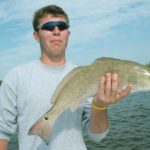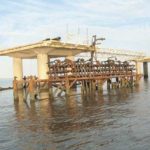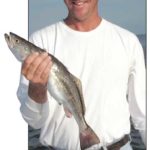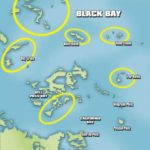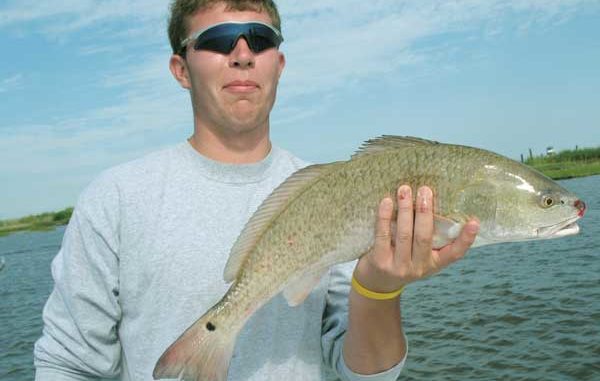
After being inundated with fresh water, Black Bay has roared back.
This was a brutal spring for anglers, guides and marina operators in Southeast Louisiana.
The dangerously high Mississippi River peaked at near flood stage and seemed to park there, requiring the opening of the Bonnet Carre Spillway as a safety precaution. The cold and muddy fresh water displaced most of the salty waters of Lake Pontchartrain, and collided downriver with the warm waters of the Gulf.
The muddy water quickly spread everywhere on both sides of the river, even into Black Bay and Breton Sound, normally impervious to such displacement.
I made several forays into Black Bay just to survey the area, and was met with muddy river water everywhere. My normally productive late-spring hotspots were barren. Everyone feared the worst for oysters, crabs and the upcoming shrimp season, and if the shrimp were displaced, there would be a meager trout catch in the normally productive waters.
But a couple of recent runs into the big bay have allayed my fears, at least regarding the shrimp and specks. In fact, like a company that finally gets out of the red and starts moving into the black and actually shows a profit, I’m happy to say that Black is back.
The shrimp are jumping out of the water, and hungry specks are chasing them all over the bay.
I met Capt. Jack Payne for the first time last month at the dock of Serigne’s Marina in Delacroix. He backed his 24-foot Kenner into Bayou Terre aux Boeufs, and I tossed my gear into the boat. Payne’s girlfriend, Cindy Berry, and friend, Craig Wescott, were already aboard, and I hopped in and readied myself for the run to Black Bay.
As we putted toward Bayou Gentilly, Payne pointed to the sign recently erected at the intersection of Gentilly and Terre aux Boeufs on the land he bought. He has boat sheds already under construction and big plans for a camp and restaurant.
Berry spent 22 years at RNO’s Seafood Restaurant on Hammond Highway at the Lakefront, and says though it will take a year or so to get it done, she can’t wait to open a Delacroix eatery.
As soon as the boat entered Bayou Gentilly, Payne hit the throttle, and the 225 Suzuki jumped up to 5,500 RPMs, and that’s where it stayed for the duration. We raced through Little Lake to the Spider Canal, and from there down Oak River to Oak River Bay.
We made this trip just a few days before shrimp season opened in Zone 1, so no live shrimp were yet available. Undaunted by the lack of live attractants, Payne was loaded up with plenty of plastics. Interestingly, he fishes with only one kind of plastic bait and in only one color.
“Salt Water Assassins, split tails, in opening night, on a ¼-ounce plain jig head. It’s all I ever use,” he said.
“We also have the same bait in the paddle tails this trip,” Berry quipped, “but only because they were out of the split tails.”
Me, I always carry a wide variety of baits and colors in my tackle bag so I can try everything. I guess that’s why it weighs almost as much as a small child.
Once we entered Black Bay, the water seemed to clear up quite a bit. Though stained, it was obvious the south and southeast winds were flushing out the muddy river water and replacing it with desirable sea water. I suspect that by July and August, the water quality and salinities will be back to normal levels.
I have to admit that Black Bay has always been one of my favorite places to fish. I always look forward to running out there every summer and trolling around the islands and structures, fishing with just about anything from live bait to plastic, topwaters and subsurface baits. I love looking over that wide expanse that stretches out for miles, and everywhere you look are islands and structures that you just know hold fish. There is something that draws me out there, beckoning with an almost imperceptible call, like a pull or tug on the sleeve, and bids me to cast a line. I plan to yield to that beckon often this summer.
Payne motored slowly to a nearby structure, and dropped the trolling motor over the bow. The rig and well structures in Black Bay come in every shape and size, and it’s not just the big ones that attract fish. This one was medium-sized, and Payne’s technique is to slowly troll around the whole structure while we all cast our baits, both under corks and tightlined. Whenever we caught a fish, he’d stop and linger in that area, allowing us to work it thoroughly to see if other fish would hit.
The conditions were near perfect — calm to light winds, almost no wave action and water, though stained, with some clarity. We could see small mullet hovering just under the surface, so there was bait in the water and the only negative factor was a tidal range of only 4/10.
“No problem,” Payne said. “They may not feed in a frenzy, but we’ll find some fish.”
And we did. The first fish was hooked by Wescott, who fought and reeled in a very nice trout, but lost it trying to lift it over the gunwale. Naturally, we derided him mercilessly for allowing such a nice-sized fish to escape due to his amateurish stop-and-jerk technique for lifting a fish over the side.
“You can’t just stop reeling at the side of the boat and jerk the fish up!” we’d say. “He’ll get off the hook! You have to keep reeling, and when the fish is approaching the boat, get his head up and lift as you reel and swing him right on up into the boat! Simple!”
He protested, of course, insisting that we stop fishing, put down our rods and get the net the next time he had one on. Naturally, it was all in fun, and teasing one another on a fishing trip is all a part of the ritual.
That was the first fish Wescott lost, but it wouldn’t be the last.
We worked around that rig for half an hour or so, and managed to put a number of decent trout in the box. Berry proved to be an adept angler, and stayed right with the rest of us, fish for fish. But the action was on the slow side and getting slower, and Payne was ready to move on.
Black Bay and its fringe bays, such as Bay Gardene, Bay Crabe, American Bay, California Bay and Long Bay, have so many islands and spits of land and rigs and wells that if you fished all day every day it’d take months to fish them all.
“Any of them could be a bonanza on any given day,” Payne said. “Don’t be afraid to try any of them. Troll around them, and if you get some action, drop the anchor and try to stay on the bite. If you don’t get any hits, move on. And don’t sit on a spot that isn’t producing. It’s easy to make the mistake of quitting a good spot too soon, or staying at a dead spot too long.
“If I absolutely know that a spot is holding fish, I’ll work it awhile even if the action is slow, just to see if they’ll turn on. Sometimes the tide may be slack or switching, and any small change will turn them on like a light.
“But you have to know when to move on, because the window of opportunity to get on the trout bite in mid-summer is only open for a short time. When it heats up, they shut down, so don’t waste your time at a non-productive spot.”
Payne dropped the trolling motor again at Stone Island, where several other boats were already anchored or trolling, and the water clarity was a bit worse. Initially, we didn’t see any of the other anglers catching anything, and what we did see was quite a few boats moving around, running from one place to another, which is a clear indication that they weren’t catching fish. Maybe that slight tidal movement was having an effect.
We worked around the shoreline, both under a cork and tight-lining, and had some pretty good hook-ups. Big schools of mullet were hanging all around us, and I decided to try a topwater bait, which brought a few explosive hits. I got nailed by a big trout that would have easily been 4 to 5 pounds, but he shook the bait before I could get him in the boat.
There is quite a bit of construction going on around Stone Island, and the constant movement of workboats and tugs can really churn up the bottom and chase away the specks. But if you happen to hit it on a day when the work-boat traffic is light, you should find some good fish.
The action started to turn up a few notches, and we caught fish and watched the boats around us land some nice trout as well. The action wasn’t confined to the island itself, but boats at the various wells and rigs nearby were also getting in on the action. We played that action out and moved again, hitting several rigs, wells and islands before deciding to call it a day.
Payne says he’ll concentrate all summer at the areas between Mozambique Point to the north and California Point to the south. Everything in between is worth trying.
“You can fish all the regular hotspots, like Stone Island and the surrounding structures, Iron Banks, which is very productive but usually crowded, Belle Island, or any of the broken islands, most of which have no name,” Payne said. “There is still some fresh water inside the fringe bays right now, such as Bay Lafourche, Oak River Bay, Bay Gardene and American Bay, but I really believe by mid summer the salinities will be back up and those spots will be red hot.
“There are plenty of trout under the birds right now, and some of the schools have decent-sized fish in them, so you might want to give that a try. But this area is relatively simple to fish. There aren’t any secrets to success except to fish a moving tide, whether rising or falling, and approach the place you want to fish as slowly and quietly as possible. Troll or anchor, fish live shrimp or croakers either under a popping cork, a sliding sinker, freelined or just with a split shot, and try topwaters and subsurface baits if you think the conditions warrant it.
Try everything, and you’ll go home with a nice box of fish.”
Capt. Jack Payne’s Sweetwater Guide Service can be reached at (504) 453-8382.
